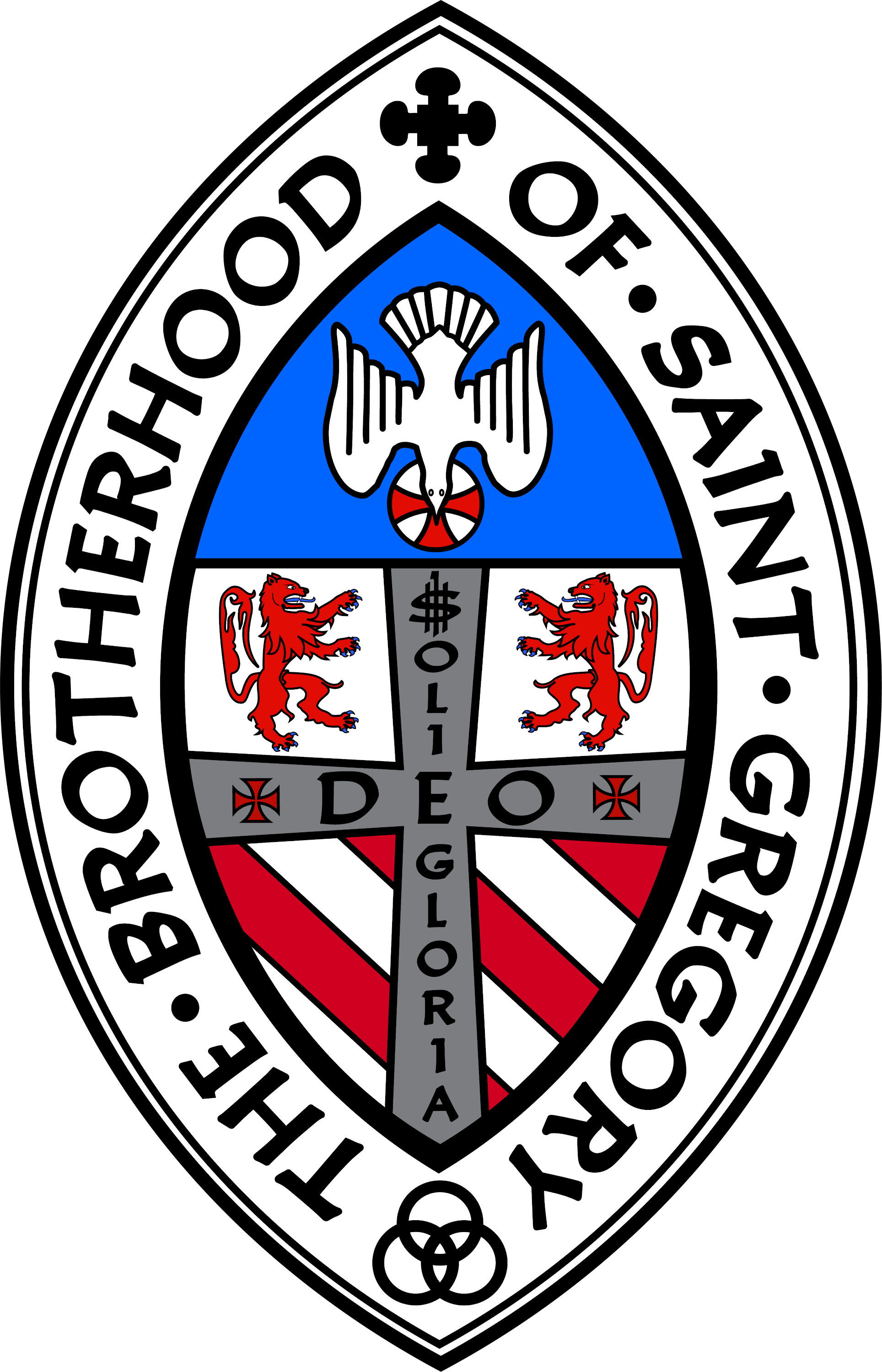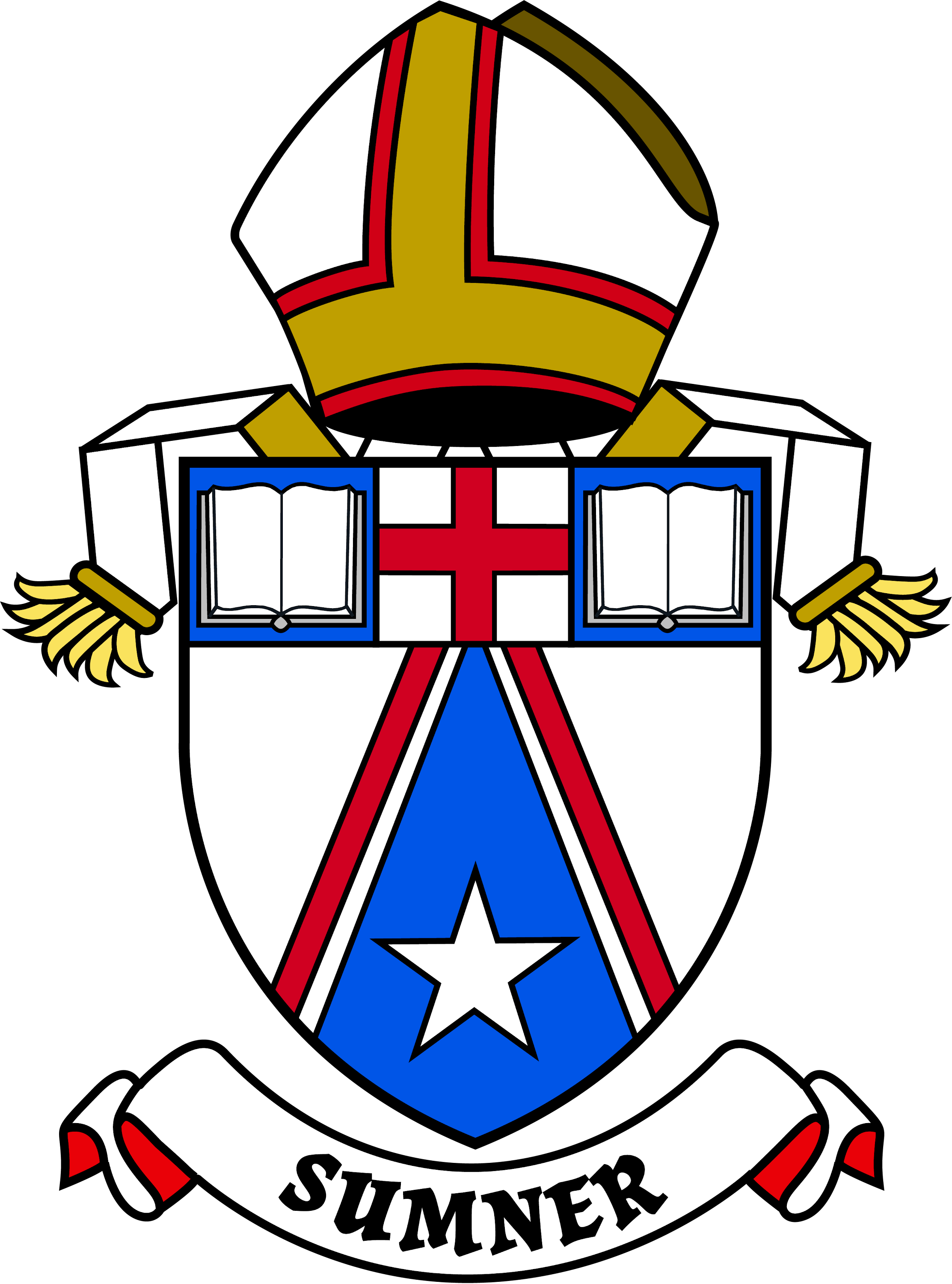 |
Coat of arms of Christ Church Cathedral (Episcopal), Hartford, CT
Rendered by Chad Krouse, 2025 |
In the Episcopal Church, external ornaments for diocesan and cathedral coats of arms differ for identification. For bishops and dioceses, the
key and crozier are placed behind the escutcheon in saltire, while a
mace and crozier are arranged accordingly for a cathedral's coat of arms. Both, however, are ensigned with the bishop's mitre with
infulae fringed and draped to the sides of the shield.
 |
External ornaments for an Episcopal diocese and cathedral
Rendered by Chad Krouse, 2025 |
External ornaments in ecclesiastical heraldry add touches of dignity while also providing additional identification of the arms themselves.
During the late 1960s, Col. Harry D. Temple (1911-2004) was commissioned by the Washington National Cathedral in Washington, DC to render arms for ornamentation of the various cathedrals in The Episcopal Church. As I understand it, many of those cathedrals did not bear coats of arms and Temple successfully designed around 30 or so cathedral arms for decoration.
As a retired US Army Colonel, Temple likely appreciated design uniformity and widely used the mace, crozier, and mitre as external ornaments in his new designs for cathedral arms. These additions help identify the cathedral as such with a militaristic flair. Not every designer would follow suit.
 |
Coat of arms of Vergers in the Episcopal Diocese of Southeast Florida
Rendered by Chad Krouse, 2025 |
 |
Arms of Trinity Episcopal Cathedral, Trenton, NJ
Designed by Col. Harry D. Temple
Rendered by Chad Krouse, 2025 |
Temple would go a step further with his cathedral template by creating a systematic method for charging the cathedral's mace with a symbol for additional identification. De Kay (1993) cites the lion passant found on the mace in Temple's design for Trinity Episcopal Cathedral in Trenton is a reference to the arms of the State of New Jersey (110). The charge is a nice reference for Trinity and an example of how Temple's method was used.
 |
Examples from Temple's designs with charges on cathedral maces
Rendered by Chad Krouse, 2025 |
In addition to the charges on the mace, Temple sometimes varied the shape and style of the cross itself adorning the top of the mace giving harmony to the whole design.
The Episcopal Church does not regulate heraldry or its use for cathedrals; however, a few attempts to wrangle in the wild west of Episcopal coat armour have been tried over the years.
The Advisory Committee on Heraldry, created during the 1982 General Convention, was a significant move attempting to standardize heraldic practice with consistency across the Church. Packed with experts from the field at that time, the Advisory Committee met only once and developed a possible framework guiding heraldry for the church. Temple was one of those heraldic experts appointed to serve. One recommendation from the committee noted that cathedrals should not bear arms, but simply use those of the diocese. The point seems rather moot as many cathedrals had arms by the 1980s thanks in part to Temple's commission with the National Cathedral. Wright (2005) further notes the advisory committee agreed that the only "mandatory ornament exterior to an episcopal coat of arms should be the mitre, of which the infulae are essential."
The advisory committee, Wright (2005) stated, did not produce a public report or distribute minutes from its only meeting. I remain curious to know Temple's thoughts on suppressing arms for cathedrals given his portfolio of work in this area. We may never know.
 |
Arms of St. Michael's Episcopal Cathedral, Boise, ID
Rendered by Chad Krouse, 2025 |
The forerunner designing arms for cathedrals in the Episcopal Church was none other than
Pierre de Chaignon la Rose (1872-1941). His first known cathedral design was created for the Cathedral of St. John for the Diocese of Quincy between 1905-1906.
Click here to learn more about la Rose's design for the cathedral and arms for the Diocese of Quincy itself. The Cathedral of the Incarnation in Baltimore and Christ Church Cathedral in Hartford are two designs for cathedral arms by la Rose included in this article. I cannot find any examples of la Rose using external ornaments in the arms for those two aforementioned cathedrals. However, I do believe we see an example of la Rose using the
key and
crozier as external ornaments in the arms of St. Michael's Episcopal Cathedral in Boise seen above. One illustration of the arms found in de Kay (1993) shows a key and crozier in saltire behind St. Michael's coat of arms. The designer is not attributed in de Kay's analysis and I believe la Rose designed these arms. As research continues, it might be possible to learn why la Rose used the key rather than a mace; perhaps he was influenced by published rolls for English sees and cathedrals.
 |
Arms of Trinity Episcopal Cathedral, San Jose, CA
Designed by the Rev. Canon Eckford J. de Kay
Rendered by Chad Krouse, 2025 |
The Rev. Canon Eckford J. de Kay (1923-2012), a former cathedral dean and military man, continued Temple's use of the mace and crozier in his designs for cathedrals. De Kay also employed Temple's method of charging the mace with an additional symbol for identification. In the arms of Trinity Cathedral in San Jose, de Kay uses the "mission bell" on the mace (De Kay, 1993, 100).
 |
Arms of Christ Church Cathedral (Episcopal), Houston, TX
Designed by the Rev. Canon Edward N. West
Rendered by Chad Krouse, 2025 |
The Rev. Canon Edward N. West (1909-1990), as far as we know, did not use external ornaments in his designs for cathedral arms. In 1966, West designed the arms of Christ Church Cathedral in Houston, TX which de Kay (1993) shows as a seal (p.119).
It seems most likely that the commission may have dictated whether or not external ornaments were created, as several cathedrals appear to use seals containing arms within a matrix rendering external ornaments obsolete with certain layouts. Within the vesica pieces design widely used by dioceses, the key and crozier with the bishop's mitre works rather well.
 |
Armorial flag of St. Matthew's Episcopal Cathedral, Laramie, WY
Designed by the Rev. Henry Martyn Medary
Rendered by Chad Krouse, 2025 |
Another variation can be found in a commission by the
Rev. Henry Martyn Medary (1871-1962), who designed an armorial flag for St. Matthew's Episcopal Cathedral in Laramie, Wyoming (De Kay, 1993, 122).
 |
Arms of Christ Church Cathedral, Eau Claire, WI
Designed by the Rev. Henry Martyn Medary
Rendered by Chad Krouse, 2025 |
 |
Arms of St. Paul's Cathedral, Erie, PA
Designed by the Very Rev. Frederic R. Murray
Rendered by Chad Krouse, 2025 |
The Very Rev. Frederic R. Murray (1910-1996) would create his own external design to support his creation of the arms of St. Paul's Cathedral in Erie, Pennsylvania where he served as dean. De Kay (1993) provides an illustration of Murray using two swords--points to base--supporting the escutcheon, a phoenix rising from its flames as the crest, and adds the motto, "Press On." Altogether something different.
 |
| Rendered by Chad Krouse, 2025 |
I wanted to see if I could add another touch, in hopes of providing identification of the see itself on the crozier for cathedrals. As such, I've placed the escutcheon of the arms of the appropriate see within the crook as an additional ornament. Hopefully, the addition does not make the design too fussy.
 |
Arms of Washington National Cathedral and the Diocese of Washington
Rendered by Chad Krouse, 2025 |
Here's an up close view of how these two pair together. The arms of Washington National Cathedral were designed in the late 1940s by Alanson H. Sturgis, whose sister was married to the dean of the cathedral (Washington National Cathedral, 1949). The Diocese of Washington's coat of arms were designed by la Rose and illustrated in Christian Art (1907, November, 59-71).
As seen, each designer added their unique touch when designing arms for cathedrals in the Episcopal Church--but the quest for uniformity in the Church's heraldry continues.
Works Cited
DeKay, Eckford. (1993). Heraldry in the Episcopal Church. Acorn Press.
La Rose, Pierre de C. (1907 November). Ecclesiastical heraldry in America II. Diocesan arms. In R.A. Cram (Ed.), Christian Art, 2(2), pp. 59-71.
The Living Church (1916, May 27). Maryland. The Living Church, 55(4), 150.
Washington National Cathedral (1949). The Cathedral Age, 24(1).






























































